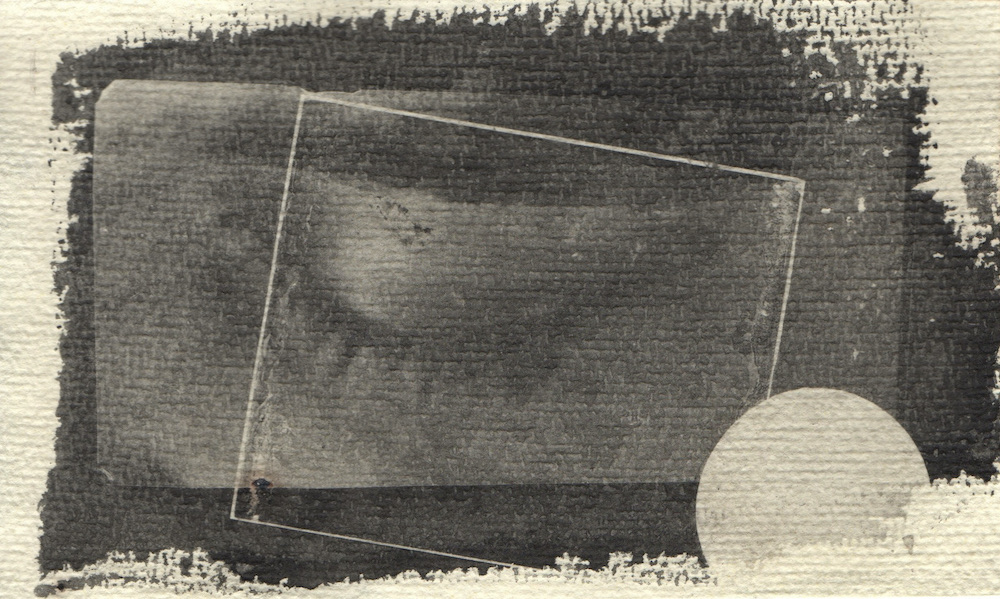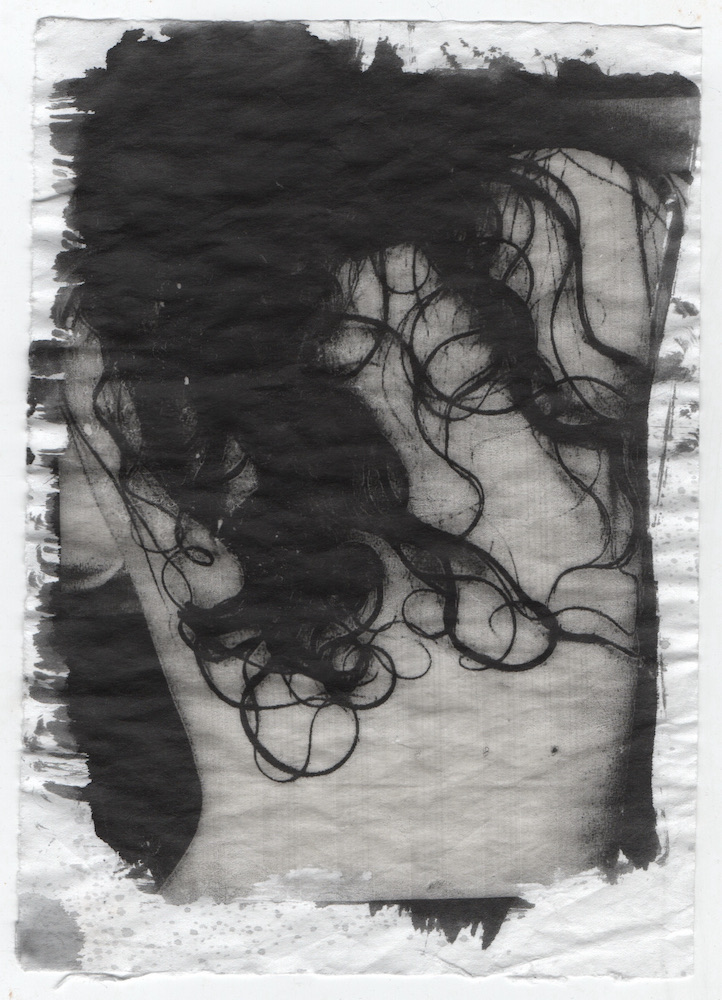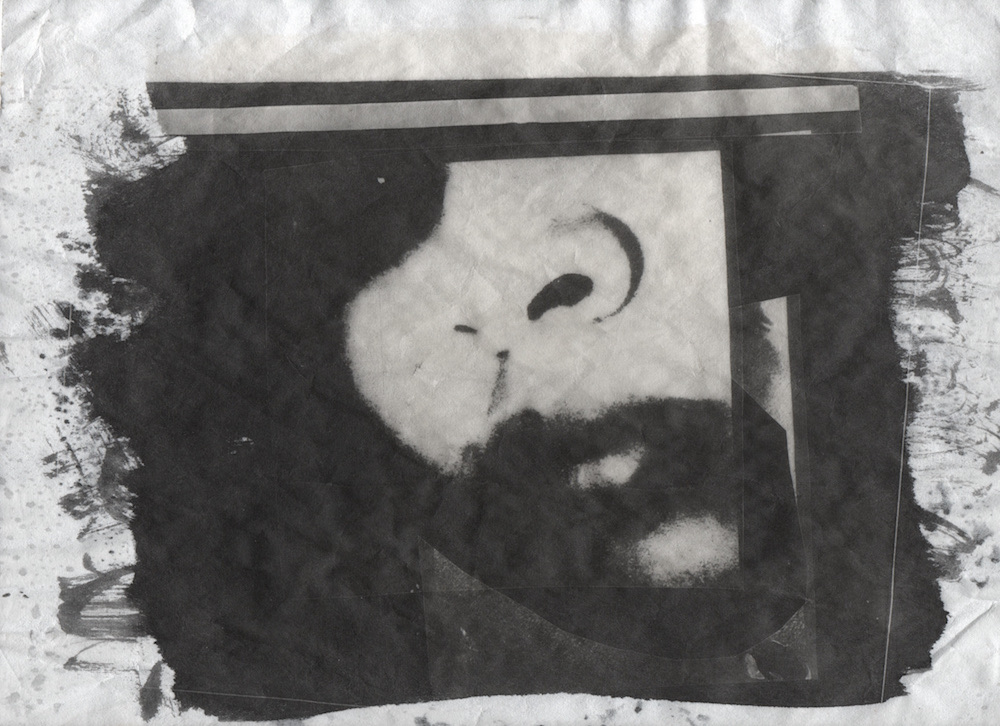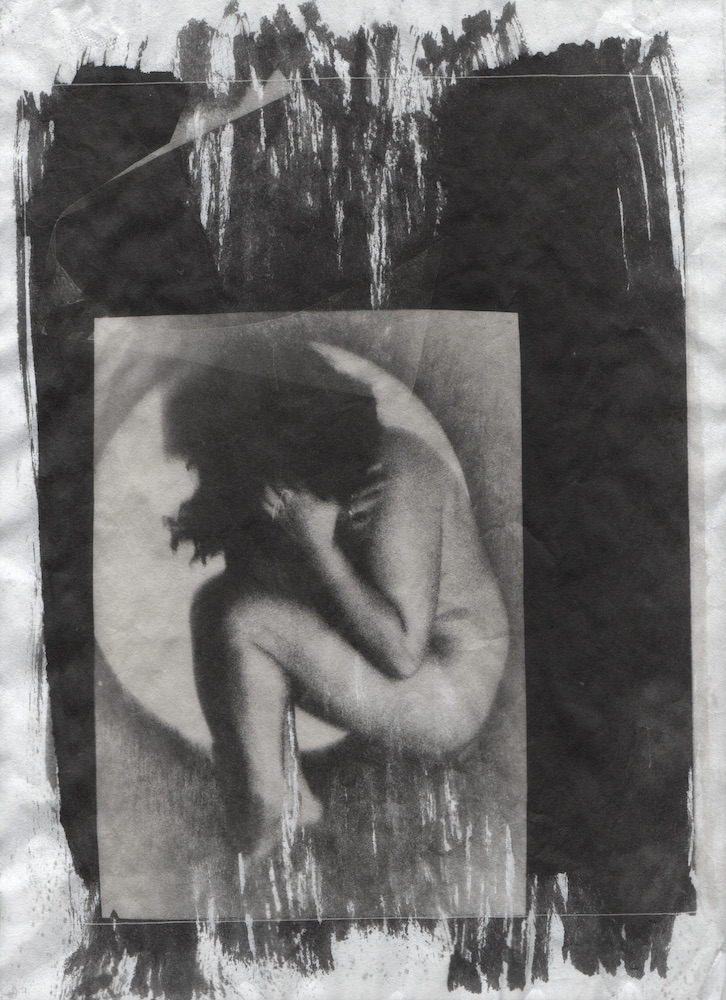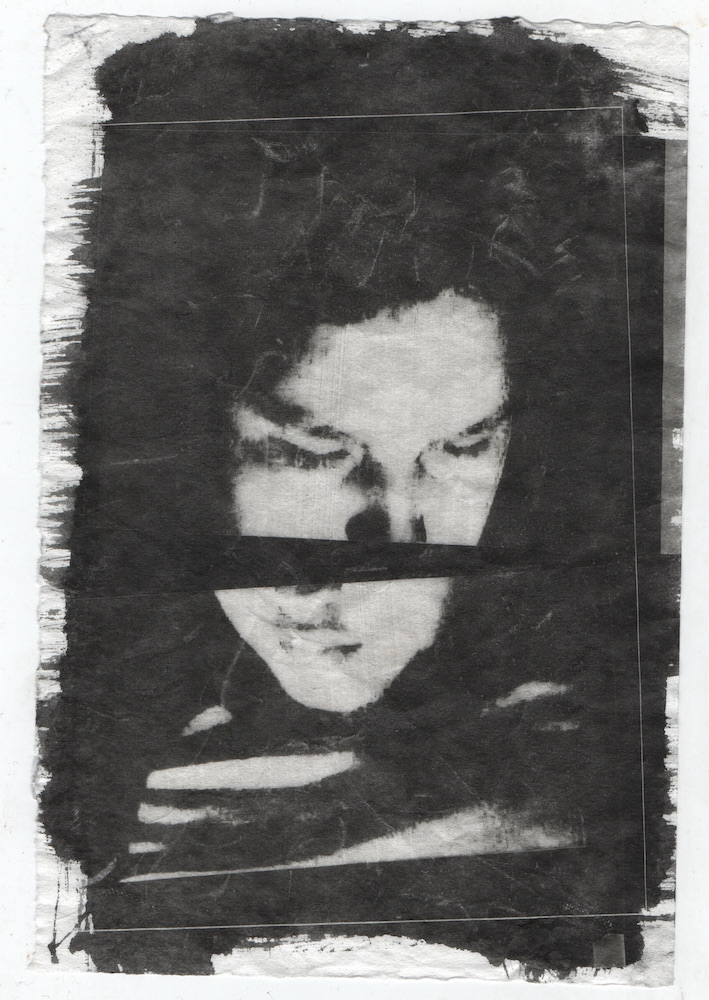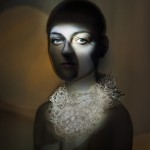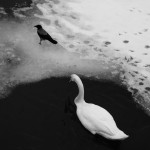The Human Experience Through Alternative Processes: Alice Campos
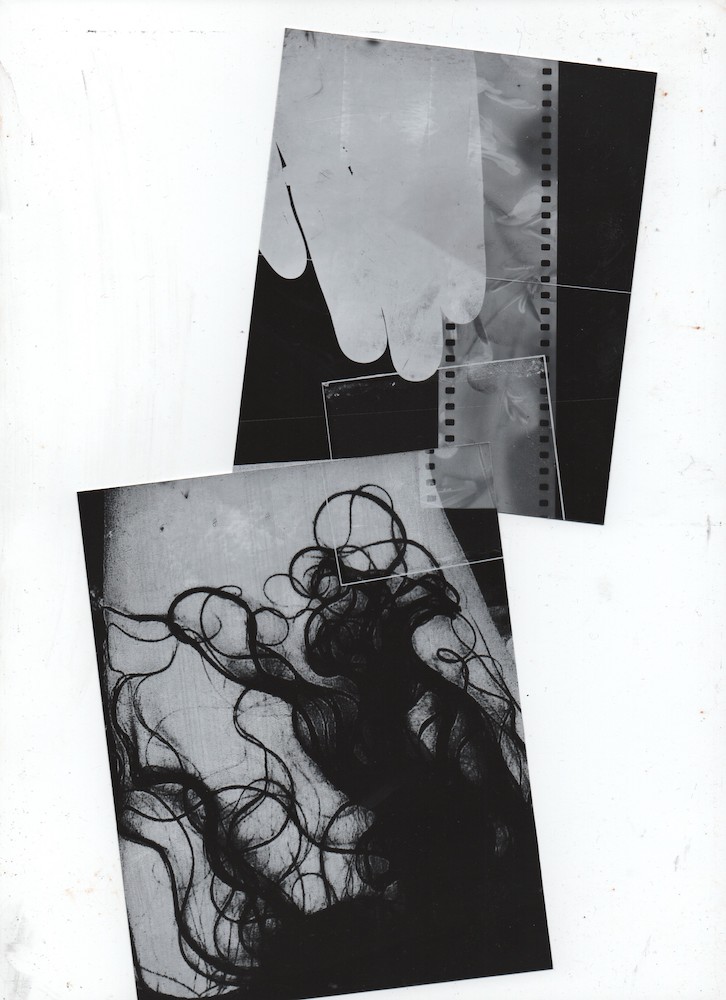
©Alice Campos, Between My Fingers Clenched a Phytogram Strip. Riddled With Fingerprints and Petal Veins. 2022, Unique 35mm black and white photograph, Printed on Foma Hard Glossy Paper, 12×11.9”, 1/1 AP.
“One way or another, we all have to find what best fosters the flowering of our humanity in this contemporary life, and dedicate ourselves to that.” – Joseph Campbell
An idea I have constantly grappled with is the idea of humanity. How is it each human being experiences similar events yet each of us is entirely unique? Due to my curiosity about how others perceive this question, I have interviewed artists that use particular photographic processes to dissect the idea of what it means to be human.
Alice Campos‘ images immediately drew me as the use of space and repetition in this body of work created a tension within me. The many different processes she uses and the way they add texture and volume to each photo allows for another layer of intrigue as viewers dissect and interpret Campos’ work.
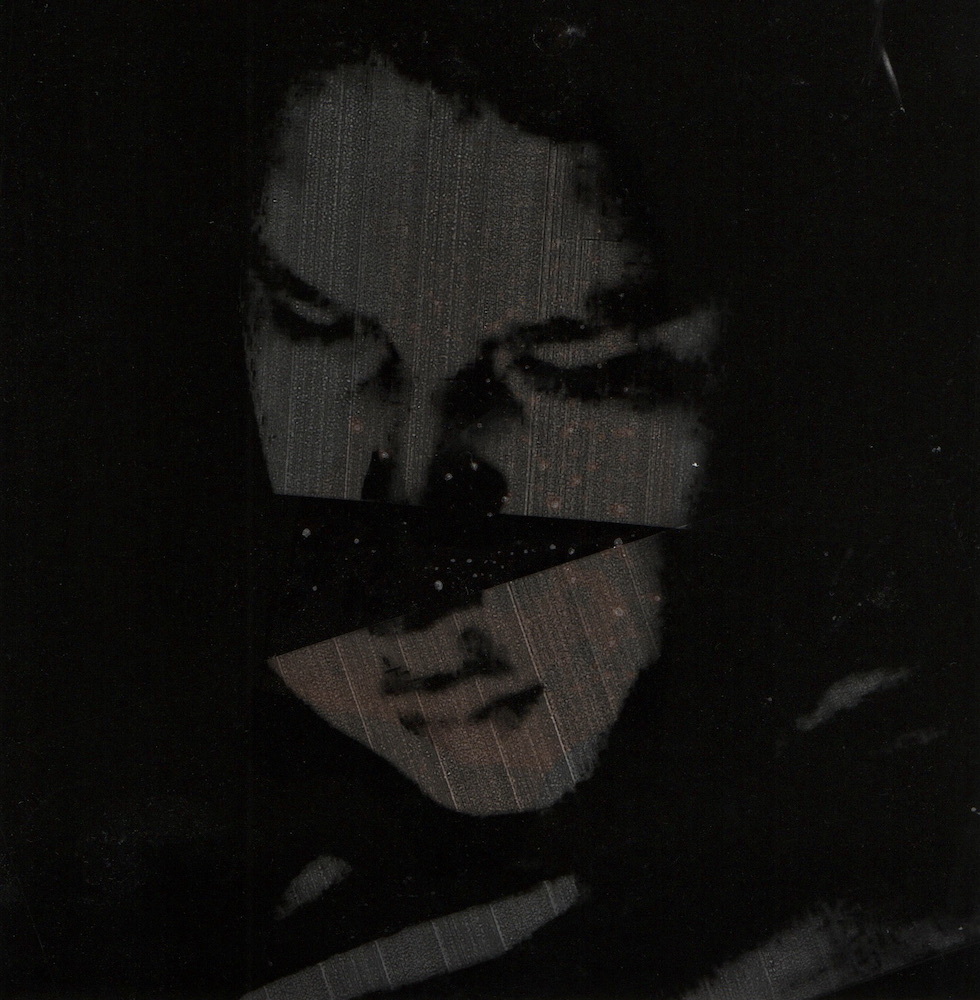
©Alice Campos, Amongst Nights, 2022. 35mm Photographic Solarised Print, Ilford Multigrade Deluxe Pearl, 5×8” inch, 1/1 AP.
Alice Campos is a British artist (b.1998), based in South East London, she graduated from Goldsmiths University in 2019 holding a First Class Degree in BA (hons) Fine Art. Campos’s practice gathers the disciplines of alternative analogue and cameraless photography, moving image, sound, sculpture and writing. Her photographic practice is represented by Open Doors Gallery and Start Art Global. In 2021 she was awarded GUP Fresh Eyes Talent, for the 100 greatest emerging European Photographers. An alumni of The South London Galleries Film School, former 2021 LCN Four Corners Artist and trainee Art Psychotherapist at BAAT.
She works independently and collaboratively, notable exhibitions have included; Berlin Short Film Festival (2017), Bright Rooms, Peckham Levels (2019), The South London Gallery, Fire Station (2020), Brighton Photo Fringe (2020), AIR Gallery (2020), Art Rotterdam (2021), PhEST (2021), Screw Gallery (2022) and Peckham Safehouse (2022).
Follow Alice Campos on Instagram: @alicecampos_z
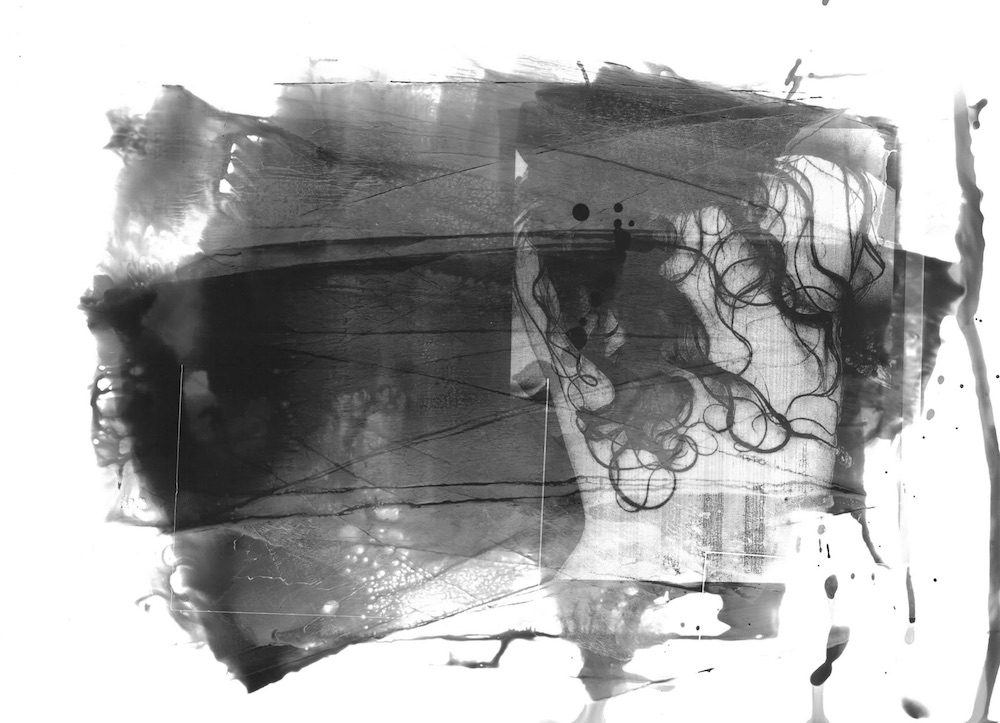
©Alice Campos, Circular Skin. Smudges. Stretched Back. Wet Hair. 2022. Unique 35mm black and white photograph. Printed on Kentmere Fine Lustre Paper. 1/1 AP.
Flesh
My practice has a fascination with romanticizing human encounters by staging fictitious scenarios. Capturing the immaterial nostalgic touch and impermanent human presence, in the forms of dancing and fleeting golden light on wrinkled skin. The blushes of purple flesh, curled wet porous hair and softened eyelashes resting on silver nitrate riddled cheeks. I tinker these staged scenarios with alchemical formulas and organic handmade photographic developers. Through distilling these moments with handmade Rosemary developers, these photographs investigate a spiritual life cycle of a death and rebirth of resin-eating Mushrooms and recycled photographic paper. The material and immaterial are married, existing through the physical discoloration of the photographic prints and the fantastical molecular regenerated entities and energies of recycled Resin and Silver Nitrate, bringing the buried captured moments into the other realm existing for our eyes. The human subjects of the photographs both exist as a romantic and grotesque scenario that I indulge in while developing and dipping into Rosemary waters. Fantasizing the fantastical abilities of rebirth and the reincarnation of lived captured moments, that now live amongst us within an unseen dream state, supported by factual scientific methodology of what the notion of recycling means.
Bouncing between sustainability within the darkroom, fictitious romanticism, scientific molecular technology and spiritual energies, this research considers ideas of an artist’s fantasy, factual nature and phantastic spirituality. The act of fixing a print holds the molecular weight of past dying waste photographs, resin sucked through Mushroom veins and shards of Rosemary photographic blood. The molecular weight brings the fantastical to the photographic print alongside the Rosemary photographic blood blushing through it.
Researching the potential of Pestalotiopsis Microspora Mushrooms, I have grown Oyster Mushrooms from spores and buried resin coated photographic paper waste beneath the soil, collected from my darkroom, including test strips and mishaps’. Carefully dissecting and observing the potential of the Mushroom’s ability to break down the resin coating on the surface of darkroom papers, such as Ilford and Foma, once the paper turns to smaller particles and the Mushrooms begin to die, I will pick them to eat and reuse the paper filled soil for Rosemary plant beds.
The buried photographic resin prints will live on through the veins of the Mushrooms. The concept of burying photographic prints, is to explore a factual and phantasic spiritual life cycle. The fundamental weight of my research is to find beginnings to an end and placing a dying photographic print into the earth to be regenerated in the form of Mushrooms, finally to be transformed into new photographic prints.
The soil underneath the resin veined Oyster Mushrooms contributes to the growth of neighboring Rosemary, which I will pick and boil to create a natural sustainable Rosemary developer. Rosemary developer can be used instead of standard Ilford chemical developer.
Exploring a full life cycle, the resin-eating Mushrooms and photographic paper waste will exist within the photographic prints. It will exist within the shards of Rosemary giving purple hued veins to the Liquid Emulsion Portraits. Once the Mushrooms perish, Chemigrams will be made from their skins and Phytograms from phenol filled plants.
This research uncovers a deeper analysis of sustainability, recycling in the form of both the factual and the spiritual, fictional and phantastic life cycle. The sublime feeling of romanticism and grotesque intrigue gives perception of obsession and dreamlike states of mind, repeating and existing within our physical space through its birth from the darkroom. Liquid Emulsions, Chemigrams and Solarised photographic prints form the stages of birth, in between and final degradation of collapse. Liquid Emulsions give presence to the birth of liquid light, whilst Solarisation separates and slices in betweenness, visible when you move with the print and finally Chemigrams made from dying Mushrooms.
Washing the deceased Mushroom skins from my photographic papers using collected rainwater, the sky also offers me the potential to develop Cyanotypes, opposite to the ground of Fungi. -Alice Campos
Kassandra Eller: How did your photographic journey start?
Alice Campos: I recall a memory, early on in my photographic journey that has always remained with me. I shot four, round framed 600 Black and White Polaroids. Intimate shots, dreamlike state, pale skin, feet shrouded in white cotton sheets, and a blurred jugular. This was an attempt to capture the variable states of rem, the final sweet rounded Polaroids felt closer to inactivity and death than they did to the high activity of a brain. This activated in me the obsession with collecting ‘beginnings to the end’. Collecting human, non-human and immaterial memories of nostalgic touch and human presence. Flesh, human hair, wrinkled skin and soft eyelashes.
The ‘gap’ has always been the starting point for me. This gap contains empty moments, actions that are yet to be conducted by our thoughts. And this gap can be stolen with the shot of a camera. A gap holding a moment that never existed.
KE: How did you discover alternative process photography? What made you want to experiment with this?
AC: The Darkroom is a passage into alternate realms, within these realms moments can be distilled and memories reenacted. Existences vanished.
The process of a ‘perfect alchemical’ formula attracted me to alternative photography. The birthing, uniting and sundering of tinkered time, light, chemicles and Silver. Nestled between thin plastic negatives are overlapping strange atmospheres, suggesting alternate realities.
KE: Is there anything or anyone who inspires you?
AC: I adore Sally Mann, Lindsay Seers, Francesca Woodman, Olivier Pin-Fat, Simon Larbalestier and Joel Peter Witkin to name just a few.
I found myself heavily attached to Lindsay Seer’s works and self published book Human Camera, where she is both the photographer and protagonist. Seers ‘Optogram’ series, where pieces of light sensitive paper were held in her mouth and her lips used as shutters, simply fascinated me. The final images were fogged and flushed with hues of blood red.
Many of Lyle Rexers words from, The Antiquarian Avant Garde, really resonate with me. Rexer states that each print evokes a sense closer to technical information and conceptual metaphors, when you are reengaging with the physicality of photography, the process and material quality.
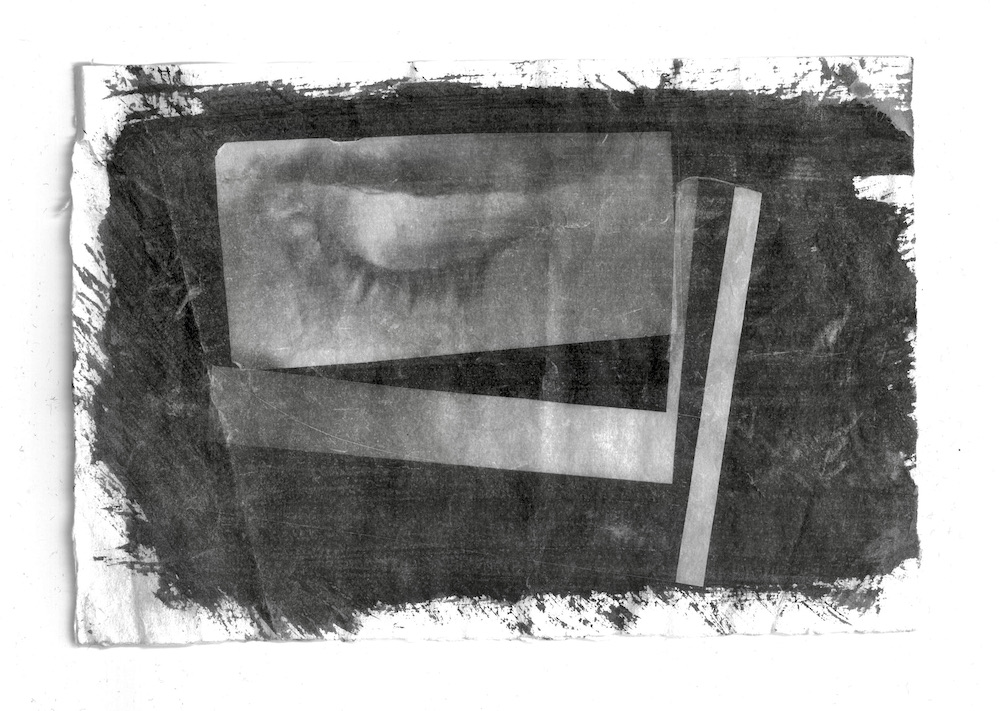
©Alice Campos, Here it, 2022. Unique Black and White Liquid Emulsion Print. Printed on Handmade Shoji Paper, 9.1X6.11”. 1/1 AP.
KE: Alternative process photography allows the artist’s hand to be present in the work. For this project why did you choose this alternative process method and how does your interaction in creating the images affect the meaning of the work?
AC: Flesh began with Gelatin Silver prints sprinkled with cameraless photography techniques such as; chemigrams, photograms and multiple exposures, but it became necessary to delve into more intimate techniques. Liquid Emulsions are crumpled, soft, uneven and imperfect, not dissimilar to our own skin. Painting Liquid Emulsion onto handmade Khadi and Shoji papers was intimate. The papers are skin like, delicate with a soft texture, but under water are strong and resilient. When bathing my Liquid Emulsions in the Darkroom wet trays, it became a sensual pleasure, fragile but taught, heavy, drenched in chemicals.
Flesh as a series focuses on my fascination with romanticizing human encounters by staging fictitious scenarios. Capturing the immaterial nostalgic touch and impermanent human presence.
Alongside these fascinations I was investigating Sustainability within the Darkroom. Liquid Emulsions allowed me to align these two together. By developing my prints in homemade Rosemary Developer I was creating a spiritual and literal life cycle, the Rosemary grew from soil beds containing mushrooms that are scientifically proven to degrade the plastic resin layer of photographic waste papers.
This changed the meaning of the final Liquid Emulsions, the material and immaterial are married, existing through the physical discoloration of the photographic prints and the fantastical molecular regenerated entities and energies of recycled Resin and Silver Nitrate, bringing the buried captured moments into the other realm.
KE: How do you handle mistakes when using alternative processes? Are there times when an error turns into a piece?
AC: Photography has strict rules to ensure succession. These strict rules can also go the other way, where mistakes are likely to happen. I of course lightly abide by these rules, to allow chemistry to do its thing, but I also go against this and play with the omnipotence that a human can have over alternative photography.
Mistakes allow me to understand and learn what the image is about. To go back into my memories and understand my emotions at that time, understand the variables of making a photographic print. The temperature at any given time, the light source, time and instinctual handling. It is completely natural and near impossible to replicate. This uniqueness is present in humans just as it is a photographic print.
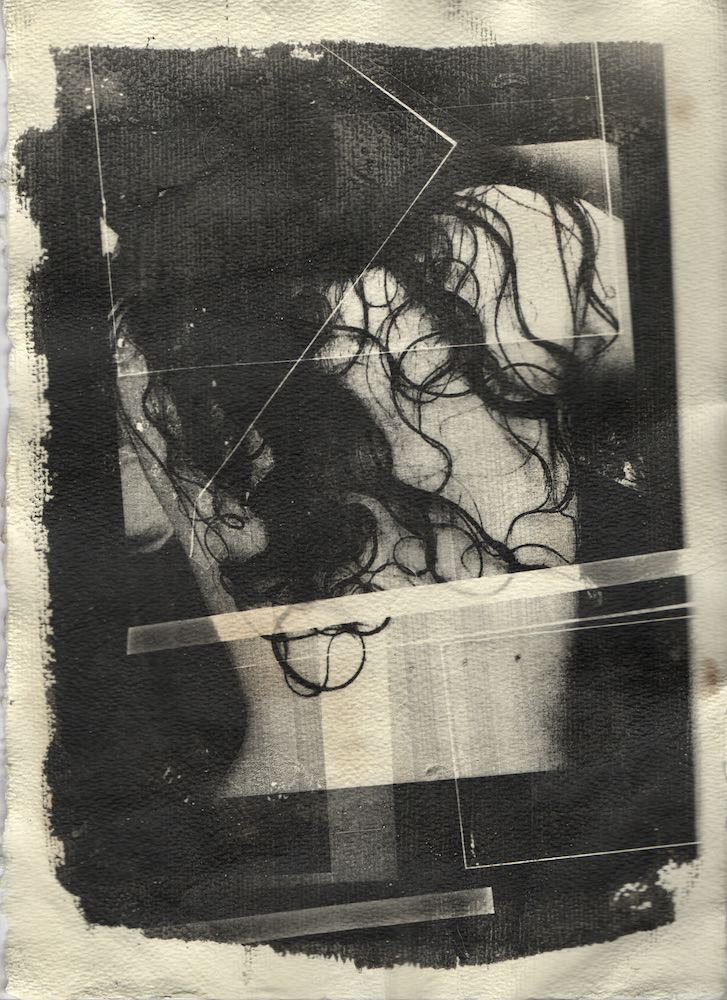
©Alice Campos, Light trickles amongst ringlet hairs. 2022 Liquid Emulsion, Khadi Paper, 11.5×8.5” inch, 1/1 AP. Developed using Rosemary Tea.
KE: You discuss research in your project statement and I would love to know what the steps were when creating this project. Did you research first or did your idea for this project become a catalyst for the research?
AC: Flesh itself is an obsession, all my series are research based, but as Flesh evolved it became obvious that more research needed to be undertaken for the series succession to feel complete. Flesh uncovered a deeper analysis of sustainability, recycling in the form of both the factual and the spiritual, fictional and phantastic life cycle.
After I began using handmade Rosemary Developers the final prints held the research, but in the form of the unseen. I then found myself researching both human encounters and sustainability, trying to figure out how to indulge in creativity sustainably.
KE: Humanity encompasses a vast array of emotions, actions, ideas, and thoughts. How would you describe your work in terms of the human experience?
AC: The sublime feeling of romanticism and grotesque hopefully intrigues and gives perception of obsession, repetition and dreamlike states. Liquid Emulsions, Chemigrams and Solarised photographic prints form the stages of birth, in between and final degradation of collapse. I want the experience of my prints to give the viewer a sense closer to a fragmented life cycle. Liquid Emulsions give presence to the birth of liquid light, whilst Solarisation separates and slices in betweenness, visible when you move with the print.
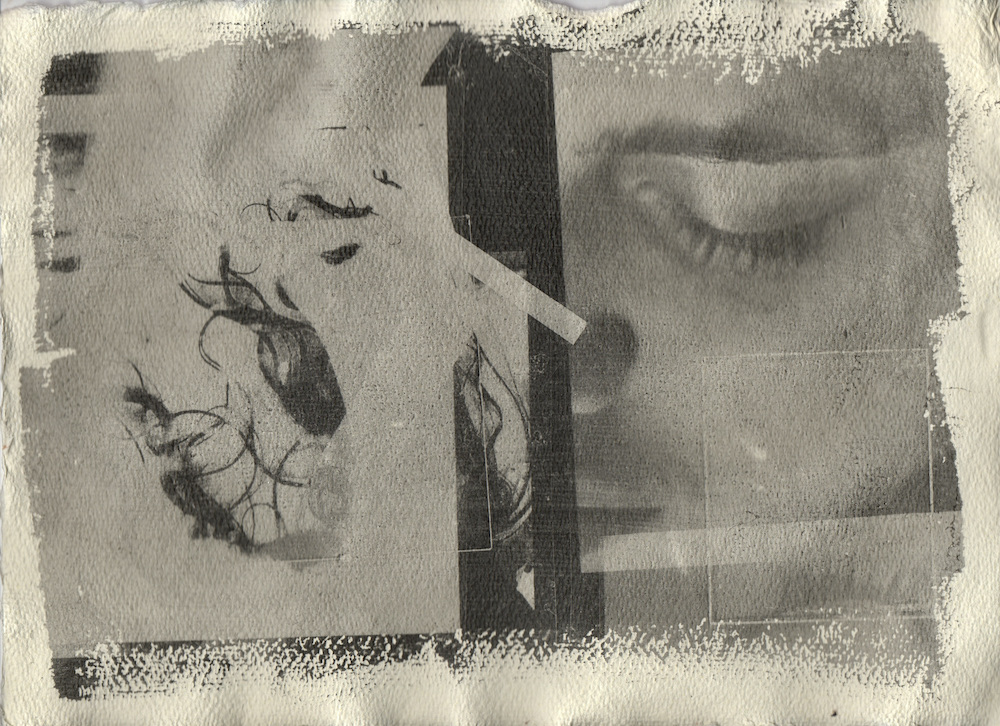
©Alice Campos, Wrapped amongst strands. 2022 Liquid Emulsion, Khadi Paper, 11.5×8.5” inch, 1/1 AP. Developed using Rosemary Tea.
KE: Your pieces are all quite provoking. The way the hair falls and the use of expression all lead viewers to see the way humans begin to fall apart. How did you conceive of these compositions?
AC: Compositions within my photographic prints are instinctual, I allow the enlarger light and chance to play a big role within my practice. I don’t see my photographic prints as falling apart but rather having a tension. It is interesting to hear that they seem as if they are falling apart, in a sense my prints are a reincarnation of a lived captured moment that is locked into the paper.
However I like this idea of falling apart, as on occasion I partially fix my prints, so overtime they will change with light exposure- eventually either disappearing or turning golden brown.
KE: I also notice that your work contains repeated images used in different ways. Would you discuss why you choose to use the same image for some works?
AC: My early practice was heavily Moving image based, like Super 8 and 8MMl. For me the repetition of the same or similar negatives allow a sense of time, just like a film strip, hundreds of the same shot only slightly differing each time. I like to think of my photographic prints as Film stills, they are very much existing in paused perennial.
I also repeat images to give the viewer a sense closer to the subject, a familiarity which results in phantasmagoria for the viewer. Repeated memories in one’s mind that never really existed but are now embedded.
KE: In these photographs, the subjects appear to be women. Why did you choose to photograph women for this project?
AC: Gender plays no role within my practice. Many of the prints are actually male, one is myself. I think this presumption is interesting, it says a lot about you who asks the question to me. You must have memories of a woman similar to the works in Flesh?
KE: I actually do. The figure reminded me of myself as I utilize self portraiture in a my own work. It seemed as though I was seeing myself in each piece.
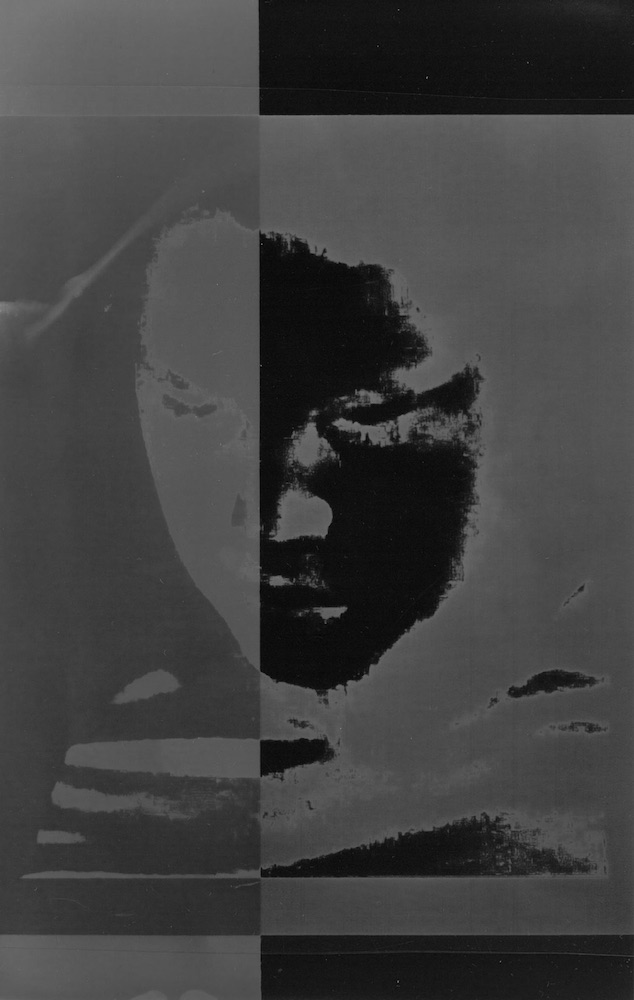
©Alice Campos, Blank droplets of nitrate light. 2022. 35mm Photographic Print, Kentmere Fine Lustre Paper, 5×8” inch, 1/5 Handmade Variations Unique Prints. Developed using Rosemary Tea.
KE: There is only one image that includes the entire body in the image while the others portray more intimate close details of the face or body. Can you discuss your thoughts on the full body image versus the up-close details Shots?
AC: The full body image is a self- portrait, whilst others are not.
I was approached by a fellow artist asking why I was never in my photographic research. I simply thought I do not have an interest in my own intimate being. However I thought it was important to have myself represented within Flesh as a body because I had never seen myself in this way.
Whereas intimacy with others, usually sleeping bodies is a tranquil moment that I feel must be captured or will be lost. Perhaps I have an obsession with keeping fleeting moments of others. With myself I know I will always be there.
KE: To conclude I would like to ask what is next for you. Is there anything you are currently working on?
AC: I am working on a new series of works, I am also exploring further Sustainability in the Darkroom and finishing my final Flesh Self-Publication.
Posts on Lenscratch may not be reproduced without the permission of the Lenscratch staff and the photographer.
Recommended
-
Ragne Kristine Sigmond: Portraits of Painterly LightDecember 2nd, 2025
-
Mary Pat Reeve: Illuminating the NightDecember 1st, 2025
-
Ricardo Miguel Hernández: When the memory turns to dust and Beyond PainNovember 28th, 2025
-
Pamela Landau Connolly: Columbus DriveNovember 26th, 2025
-
MATERNAL LEGACIES: OUR MOTHERS OURSELVES EXHIBITIONNovember 20th, 2025

